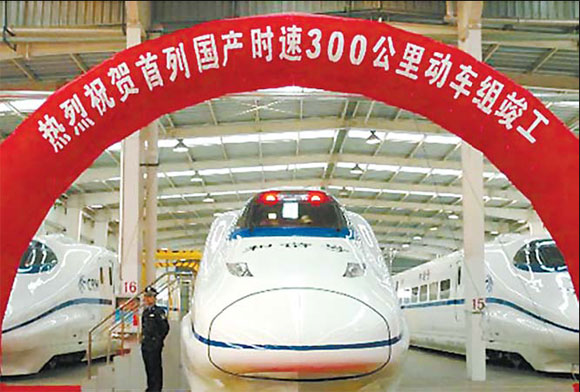Qingdao, famed for hi-tech, has more in pipeline
By Du Shu (China Daily)
Updated: 2008-03-06 11:31
Updated: 2008-03-06 11:31
 |
|
Trains that can reach 300 km an hour are built in Qingdao. [China Daily] |
As a national pilot city for technological innovation, Qingdao has laid plans to boost both its own and the country's development through creation of more innovation, said Mayor Xia Geng in a recent interview.
The city now has 700 hi-tech enterprises that had a combined production value of 309.4 billion yuan last year, an increase of 28.7 percent over 2006.
About 75 percent of hi-tech products made in the city have independent intellectual property rights (IPR). Progress in science and technology has been responsible for more than 50 percent of the city's development.
The city has in recent years attracted six national science and research institutes and 12 national enterprise technical centers
Companies based in Qingdao have made breakthroughs in more than 50 core technologies through independent IPRs, including from appliance maker Haier Group that became an international standard adopted by the International Electrotechnical Commission. Other patents of international significance include those from HiSense Group for microchip technology used in color TVs and a collaboration by Sifang Locomotive and Rolling Stock Co to build a train that can reach a speed of 300 km an hour.
Enterprises based in Qingdao develop more than 4,000 new products every year, more than 50 percent of which have independent IPRs.
Haier, the fourth-largest household appliance maker in the world, invests more than 4 billion yuan in research and development (R&D) annually, producing an average of 2.5 patents each day. The group now has 5,400 patents that have strengthened its competitive edge, helping it generate $2 billion in annual export revenues.
A microchip invented by HiSense broke the monopoly of foreign firms in core color TV technology. Some 75 million digital high-definition TVs produced in China every year now employ the HiSense chip.
Qingdao is called "the city of Chinese brands" as a result of 74 products awarded the status of Chinese world famous, Chinese brand name and famous Chinese brand. The city's hi-tech industries include those making electrical appliances, machinery, communications equipment, electrical devices, chemicals and cars.
According to the 11th Five-Year Program (2006-10), the production value of Qingdao's hi-tech industries will reach 700 billion yuan and account for 50 percent of the city's total industrial output by 2012.
The city's patent applications are projected to increase 15 percent annually to a total of 82,000 by the end of 2012, when the number of hi-tech companies will surpass 1,200.
The plan says that Qingdao will accelerate technology development and innovation in household appliances, new materials, petroleum chemicals and machinery equipment manufacturing. The electronics information industry is expected to hit sales revenues of 400 billion yuan by 2012 through an average annual growth of 20 percent.
Spending on scientific and technological innovation will exceed 50 billion yuan over the five-year period, during which time breakthroughs of international significance are expected in 40 key technologies.
The plan calls for Qingdao to strengthen the development of 10 industries, including software, new materials, high-speed trains, bio-energy and marine equipment, that are together projected to generate a production value of 100 billion yuan every year. The city's industries will also hire more talent for science and technological innovation.
By 2012, its technicians are expected to total 100,000, with the number of scientists and engineers surpassing 70,000.
The city plans to cooperate in international technology with nations including Russia and Germany, as well as China's premier institutes, including the Shenyang branch of the Chinese Academy of Social Sciences in Liaoning province. A Sino-French marine science and technology center will also be further promoted.
|
||
|
|
